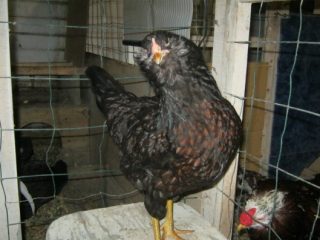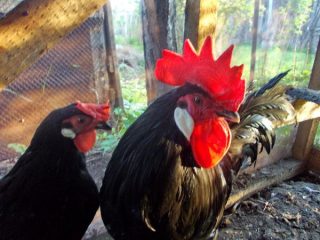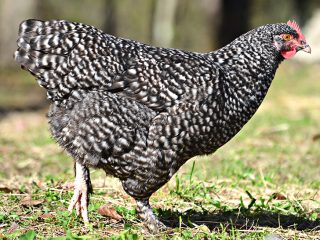Content
The Legbar chicken breed is quite rare. Breeding scientists Michael Pease and Reginald Punnett from the Genetics Institute of the University of Cambridge in the 30s were breeding chicken breeds with autosex properties (the ability to determine the sex of chickens by the color of their down at one day of age), but at the same time, so that the chickens are distinguished by high egg production.
Golden legbar chickens are the result of crossing Leghorns and striped Plymouth Rocks, and were standardized in 1945. The resulting Golden Legbar was crossed with a White Leghorn and a Golden Kempinian cock to produce the Silver Legbar in 1951. Next, he was crossed with a white Leghorn and Araucan. Result: cream legbar, which was presented at the agricultural exhibition in 1958. The new breed of chickens laid blue eggs. For some time the breed was not in demand and almost disappeared. About the Legbar chicken breed, watch the video:
Description of the breed
The description of the Legbar breed is as follows: Legbar roosters are powerful birds. They have a wedge-shaped body, a broad chest, and a long and flat back. The tail is moderately full and inclined at an angle of 45 degrees. The wings are pressed tightly to the body.The head is small, the comb is erect, bright red in color with 5-6 distinct teeth, the earrings are light in color; in chickens, the comb has a leaf-shaped shape with 6 teeth, is not always erect, and can bend to one side from the middle. The eyes are bright orange. The legs are yellow, thin but strong, with 4 widely spaced toes.
The birds' plumage is soft and silky. A distinctive feature of Legbars is the crest on their head. Therefore, the breed is often referred to as “crested legbar”. Look at the photo to see what representatives of the Legbar breed look like.
In total, depending on the color, three types of legbars are distinguished - golden, silver and cream. Today, the most common is the cream color of legbars, which combines silver-gray and soft golden shades, creating an overall cream color. Cockerels have clear stripes, while hens do not have them. In addition, the plumage of Legbar chickens is darker, with a predominance of brown shades: from soft cream to salmon-chestnut with a bright feather edge.
Legbar chickens have a clear autosexism.
In cockerels, the stripe is blurred and blends into the main background, unlike hens, in which the edges of the stripe are clearly defined. In the photo you can clearly distinguish Legbar hens and cockerels.
Legbars have a good disposition; you won’t find them arguing with each other or other breeds. But the cockerels jealously watch over their friends, protect them and do not allow them to be offended.
Chickens of this breed are very active and love to walk.Therefore, when breeding them, it is necessary to equip a paddock for walking. This will allow the chickens not only to take a walk, but also to find some food for themselves in the form of bugs and worms. Legbar chickens require food of animal origin. And the free-range method of keeping poultry allows you to save on feed. In the summer, most experts recommend minor supplementary feeding.
Productive Features
The Legbar chicken breed has a meat-and-egg production. Despite all the beauty of the external data, the productive abilities of the chickens did not suffer at all.
- Chickens lay hard-shelled blue or olive eggs weighing up to 60 g;
- High egg production persists for 2 years;
- Legbar chickens begin to lay eggs at 4-5 months of age;
- About 220 eggs are produced per year;
- The live weight of legbar chickens reaches 2.5 kg, roosters 2.7-3.4 kg.
The qualities of the breed listed above have led to it becoming quite popular.
Cons of the breed
When keeping the breed on private farms, it is necessary to keep in mind some of the disadvantages that are inherent in Legbars. Without taking them into account, effective breeding of the breed is impossible. The disadvantages of legbars include:
- Every 2 years, replacement of the livestock is required, since egg production drops sharply after 2 years;
- Legbar laying hens have practically lost their brooding instinct. Some poultry farmers attribute this to the agile nature of the Legbar breed. However, breeders will have to worry about purchasing an incubator;
- During the cold season, egg production decreases and may stop completely. Therefore, in order to receive eggs in the cold season, the poultry house should be insulated. It may be necessary to install a heater. The main thing is that the temperature in the room is above zero.At a temperature of +15+17 degrees, you can count on maintaining egg production in the same volume.
The last drawback has a significant impact on the further spread of chickens of this breed in the difficult climatic conditions of Russia.
Content Features
It is believed that legbars are selective about food and will not eat what other chickens eat.
Feed for the Legbar breed consists of 5-6 components. Then such a combined feed will be well eaten by poultry, and the chickens will receive all the necessary elements from food for vital activity and high egg production.
Pour shell, limestone, chalk, and crushed egg shells into a separate container. In order for a chicken to lay a high-quality egg, a lot of calcium is required, much more than she can get from food.
In the summer, be sure to add greens and seasonal vegetables to your diet. If you feed your chickens wet mash, make sure it is eaten right away. The remaining food spoils and turns sour.
In young individuals, obesity leads to a delay in the beginning of the egg-bearing period. In adult chickens, the number of eggs laid is significantly reduced.
Laying hens consume almost 2 times more water than feed. In summer, change the water 2-3 times, in winter less often.
Fresh air is supplied through a regular window.You can also equip supply and exhaust pipes by providing them with plugs, so you can regulate the air flow, which is especially important in winter in order to preserve heat.
The poultry house should be well lit. Natural light comes through the windows; in winter, when daylight hours are short, additional lighting is required.
Keep it clean. Change the bedding often. Be sure to do general cleaning twice a year followed by antiseptic treatment.
The poultry house must be equipped with perches, nests, drinkers and feeders for chickens.
Make perches from rounded poles at the rate of 20 cm perch per hen. At a height of 1 m from the floor and at a distance of 50 cm from each other. The most convenient placement of perches is in the form of a ladder, and not on top of each other.
For nests, you can use ordinary boxes lined with straw or hay. Approximate dimensions 35x35 cm.
Conclusion
Breeding laying hens can be considered a profitable business. With a minimal investment you can make a profit fairly quickly. In the case of the Legbar breed, business can be developed not only on the basis of the sale of eggs, but also on the sale of eggs and young stock of purebred birds for further breeding. Do not forget that poultry also has a meat direction. Carcasses of slaughtered poultry have a good presentation.















